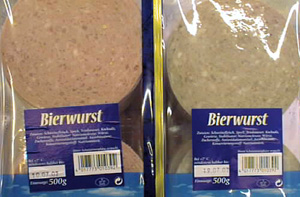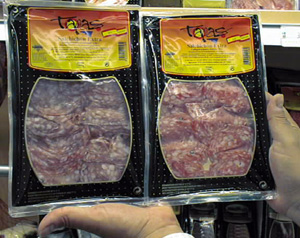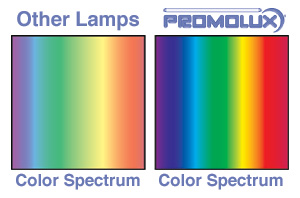Discoloration of Deli Luncheon Meat in Supermarket Refrigeration Merchandisers
Display lighting in supermarket refrigeration merchandisers causes fading and discoloration in processed meats. Cooked ham is very sensitive to the effects of light.
Promolux low UV balanced spectrum fluorescent lamps and LEDs minimize fading and discoloration caused by supermarket refrigeration merchandiser lighting.
Lunch Meat Discoloration at Full Service Delicatessen Counters

The combination of oxygen with UV and visible spectrum radiation triggers photochemical reactions within deli meat, causing cured meats to become faded and eventually greenish, and converting the red myoglobin pigment in deli meats such as rare roast beef to the brown pigment metmyoglobin.
One study found that sliced ham began to fade immediately after being exposed to light and continued to fade significantly during the first two days of display, regardless of how the ham was packaged. Ham in vacuum packages and UV-protected wrapping faded at the same rate as ham in other types of packaging.
The color pigment in cured meats is very unstable; when light oxidizes the red cured meat pigment nitric oxide myoglobin (nitrosomyoglobin), metmyoglobin nitrite is formed and the ham turns grey. Excess nitrous acid and heat creates the pigment nitrihemin, which turns cured deli meats green.
Because Promolux lamps and LEDs are designed for true color definition, they have a more balanced visible spectrum than other fluorescent lamps. The yellow and green wavelengths that are predominant in regular fluorescent lighting are the most damaging wavelengths in the visible spectrum. Promolux lamps and LEDs emit a more balanced range of wavelengths, including more of the red and blue wavelengths and more moderate levels of the yellow and green wavelengths, and they emit lower levels of UV radiation. Promolux deli display case lighting brings out the natural colors of deli meats, and extends shelf life by minimizing discoloration.
Discoloration of Packaged Meats in Self-Serve Deli Cabinets

Deli meats in self-serve counters are often vacuum packed to protect them from oxidation, but these packages tend to be transparent, allowing light to affect the color and freshness of the meat.
Sliced deli meat packages at the front of the display have the greatest exposure to display case lighting and these deli meat slices are usually more faded or discolored than the packages at the back of the display, even though they may all have the same expiration date. Self serve deli cases are monitored less often than service counters, and if the meat does not look fresh customers will conclude that the store sells poor quality food.
Regular supermarket display case lighting emphasizes the green and yellow portions of the visible spectrum to produce a bright light. However, under this lighting, food does not look appetizing. Rare roast beef can look dark brown, and white fats look yellow or greenish.
Since Promolux lamps are designed for true color definition, they have a more balanced visible spectrum than other fluorescent lamps. The yellow and green wavelengths that are predominant in regular fluorescent lighting are the most damaging wavelengths in the visible spectrum. Promolux lamps emit a more balanced range of wavelengths, including more of the red and blue wavelengths and more moderate levels of the yellow and green wavelengths, and they emit lower levels of UV radiation. Promolux deli display case lighting brings out the natural colors of deli meats, and extends shelf life by minimizing discoloration.
Promolux True Color Definition Lamps
Promolux balanced spectrum lamps and LEDs emit lower levels of heat and ultraviolet radiation than regular supermarket fluorescent lamps, prolonging the shelf life of delicatessen foods. Compared to other fluorescent lighting, Promolux lamps emit 86% lower UV B radiation, a shorter wavelength that penetrates and causes heating, and 52% lower UV A radiation, a longer wavelength that tends to affect surfaces.

Because Promolux lamps and LEDs are designed for true color definition, they have a more balanced visible spectrum than other fluorescent lamps. The yellow and green wavelengths that are predominant in regular fluorescent and LED lighting are the most damaging wavelengths in the visible spectrum. Promolux lamps emit a more balanced range of wavelengths, including more of the red and blue wavelengths and more moderate levels of the yellow and green wavelengths, which results in greater sales through better eye appeal and increased consumer impulse shopping.
